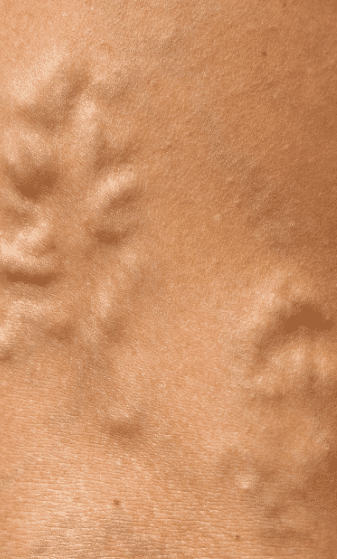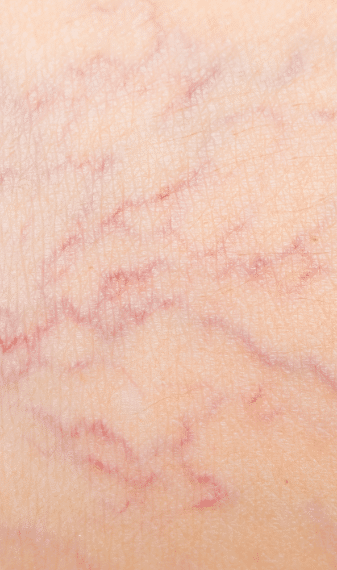What are Spider Veins & Varicose Veins?

Varicose Veins
Varicose veins are bluish or reddish veins that bulge out of the skin’s surface in a twisted, tangled, or knotted form. They’re often accompanied by leg heaviness, changes in skin color, frequent leg cramps, and restless legs.
Varicose veins occur due to underlying chronic venous insufficiency. This is a circulatory disorder wherein the vein valves in the leg veins malfunction, making blood flow backward and accumulate in the leg veins. The physicians at our vein clinics in New York perform a thorough diagnosis to identify the root cause of your varicose veins.

Spider Veins
Spider veins are dense clusters of reddish, bluish, or purplish veins visible just under the skin’s surface. They usually appear in dense clusters and spread outwards, similar to spider webs. Spider veins are most common on the face and legs, but they can also appear on other parts of the body.
Spider veins don’t cause any symptoms in and of themselves. However, they’re often symptomatic of underlying chronic venous insufficiency, and, as such, they’re accompanied by other symptoms of vein disease, such as leg heaviness, restless leg syndrome, throbbing leg veins, frequent leg cramps, and more. Vein disease occurs when your vein valves malfunction and blood flows backward, eventually accumulating in the leg veins. The physicians at our vein clinics in New York always determine the root cause of your spider veins before curating a treatment plan.
BOOK AN APPOINTMENT NOW
Vein Disease Symptoms

Rеѕtlеѕѕ lеgѕ ѕуndrоmе (RLS)
Restless legs syndrome is a condition wherein you have an inexplicable and urgent need to move your legs constantly. Your inability to remain still leads to insomnia, exhaustion, anxiety, and other problems.
Restless leg syndrome can be caused by a sedentary lifestyle wherein you sit or stand still for long periods of time. However, if your restless leg syndrome worsens at the end of the day, you may have underlying chronic venous insufficiency. Vein disease is a condition wherein blood accumulates in your leg veins, leading to restless legs syndrome. Our vein specialists in New York City examine your leg veins, trace the root causes of your restless legs, and curate the ideal treatment plans.

LEG CRAMPS
Leg cramps are sudden spasms of muscle contractions, tightness, and painful sensations in your legs, especially the thighs and calves. Most people experience leg cramps occasionally due to dehydration, electrolyte imbalances, or extended periods of sedentariness. However, frequent leg cramps, especially if they worsen at the end of the day, are symptomatic of underlying chronic venous insufficiency.
Venous insufficiency is a medical condition wherein the collapse of your vein valves makes blood accumulate in your leg veins. The continued accumulation of blood in the leg veins increases the likelihood of frequent leg cramps, especially at the end of the day. Patients often wake up in the middle of the night with leg cramps. Our vein specialists in Manhattan diagnose the underlying vein disease and curate personalized vein treatments for long-lasting relief.

LEG HEAVINESS
Leg heaviness is a condition wherein your legs feel achy and heavy. You may experience mild leg heaviness for several reasons, including exhaustion. However, persistent leg heaviness that worsens at the end of the day is symptomatic of chronic venous insufficiency.
If your leg heaviness worsens at the end of the day or after long periods of sitting or standing still, you may have underlying vein disease. In this case, exercise might alleviate the symptoms, but heat worsens the heaviness. Our experienced vein doctors in Manhattan will trace the root cause of your leg heaviness to curate the ideal treatment plan.

LEG SWELLING
Leg swelling is a condition wherein your legs are swollen, sensitive, tight, and uncomfortable. This can happen due to various underlying conditions, such as kidney failure, heart failure, lymphatic system problems, or much more. It can also happen due to high salt intake. However, if your leg swelling worsens at the end of the day or is accompanied by skin discoloration, restless legs, spider veins, or varicose veins, you probably have underlying venous insufficiency.
Chronic venous insufficiency is a medical condition wherein the collapse of your vein valves makes blood flow backward and accumulate in the leg veins. The accumulation of blood worsens with inactivity, so the symptoms also worsen when you sit or stand still for long periods. If you have leg swelling and other symptoms of vein disease, such as leg heaviness and restless leg syndrome, please contact our vein clinics in New York.
Causes of Vein Disease

Risk Factors of Vein Disease
The most common risk factors for vein disease include genetic predisposition, hormonal fluctuations, weight gains, birth control pills, a history of blood clots, or an occupation that involves extended periods of sitting or standing still, such as nursing, driving, policing, teaching, etc. A history of blood clots in the leg veins may also increase your risk of spider veins and varicose veins.
Up to 60% of all people develop spider veins at some point, which is the most common symptom of chronic venous insufficiency. Our vein specialists in New York carefully examine your leg veins, review your medical history, and use advanced vascular imaging tests to diagnose vein disease.

Chronic Venous Insufficiency
Chronic venous insufficiency is a medical condition wherein certain veins become diseased. As such, to understand vein disease, you must understand how veins function.
Veins are responsible for carrying blood from different body parts to the heart. Each vein contains a valve, a mechanism that ensures blood only flows in one direction – towards the heart. As such, vein valves act as one-way doors, ensuring optimal blood circulation towards the heart while resisting gravity. When your vein valves collapse, blood flows backward due to gravity, especially in the legs, and accumulates in the leg veins. The accumulation of blood in the leg veins leads to dilated vein walls, eventually causing spider veins, varicose veins, and other symptoms.
Contact us
Call us
Speak with one of our team members right away to get answers about insurance coverage, scheduling an appointment, and our vein clinic locations (332) 263-4887.
Book online
Request an appointment at any of our New York Vein Clinics by visiting our Book Appointment page. Before your visit, we offer free insurance verification.
Get directions
Learn how to easily get to the NY Vein clinic nearest you.
